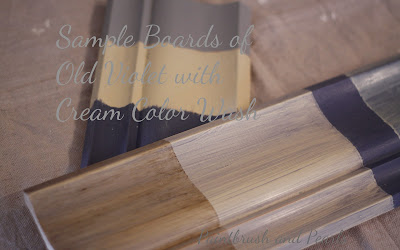Customers often pick this photo out of Annie Sloan's book Quick & Easy and ask how this look was created. I tell them that you can create a similar effect with a Color Wash.
What, you ask is a Color Wash? Basically, it can be accomplished by layering Chalk Paint® colors, using a thinned paint, to reveal either the wood or base color paint underneath. There are two types of Color Washes that I like to use for painting with Chalk Paint®.
First Method - The Limed Effect
 |
| Old White Wash - Duck Egg Base |
This method is used for "white washing" an unfinished or natural wood piece of wood furniture. It will bring out the wood grain in a piece while adding a subtle amount of color. If you hate the idea of loosing the wood grain, then this method is for you.
Step 1: Thin the paint by adding water - I use about 1/3 to 1/2 water. Don't make a huge batch since it will go a long way. I use distilled water to be sure that there is nothing in the water that will change the color of the paint, but you can use tap water.
Step 2: Apply the wash using a brush (a flat brush this time works well) being sure to cover all of the wood.
Step 3: Using a soft cloth gently work the wash into the wood by wiping the surface. The more you wipe off, the more translucent the stain will look, giving it a limed washed effect.
Step 4: Wax using Clear or Dark Soft Wax, depending on the effect. Buff gently when dry.
You have to work fairly quickly with this process so that the wash doesn't dry before you can wipe it off. As with waxing, it is best to do this in sections. If the wash does dry to much, simply dampen a cloth before wiping.
 |
| Paris Grey and Louis Blue Wash with Old White Wash |
This wash looks best over lighter woods! Old White, Pure White and Duck Egg are great colors to try.
Second Method - Two Color Wash
 |
| Paris Grey top and sides with Provence Drawer Fronts and French Linen Wash |
I personally love this look. It is a great way to use two colors on a piece to achieve a subtle toning of the paint. Pick any two colors - some suggest one light and one dark, but I have found almost amy two colors will work. You will be amazed at the color combinations that work.
 |
| Duck Egg Wash with Coco Top |
Step 1: Paint a first coat as you normally would in your base color.
Step 2: Create a Color Wash of your second color by mixing with water as above and apply over the first base coat with a brush after the base coat has dried thoroughly.
Step 3: Using a soft cloth folded into squares, gently wipe some of the wash by wiping the surface, turning the cloth over as it gets the wash on it. Try to wipe more or less in a straight line, I think it looks more natural, but try wiping in circles for a more mottled look.
Step 4: Apply Soft Clear Wax alone or with Soft Dark Wax. You will get a very different look with the two waxes. Buff gently when dry.
 |
| Anntionette with Coco Color Wash - Clear & Dark Soft Wax |
Here are some great Color Wash combos that I have used - but go ahead and create your own! And, try reversing the colors for a whole different effect.
Country Grey with Old White Wash
Olive Base with Provence Wash
Old White with Coco Wash
Cream with Old Violet Wash
Pure White or Old White over any Color
For more information on this and other layering techniques, see this Layering Tutorial.
 |
| Duck Egg and Provence Base with Chateau Grey Wash |
Rachel
Click to see more tips, tutorials and photos: Paintbrush and Pearls

















